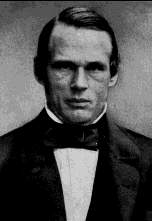|
|
Anders Jonas Ångström (August 13, 1814 – June 21, 1874) was a physicist in Sweden, one of the founders of the science of spectroscopy.
He was educated at Uppsala University, where in 1839 he became docent in physics. In 1842 he went to the Stockholm Observatory in order to gain experience in practical astronomical work, and in the following year he was appointed keeper of the Uppsala Astronomical Observatory.
Becoming interested in terrestrial magnetism he made many observations of magnetic intensity and declination in various parts of Sweden, and was charged by the Stockholm Academy of Sciences with the task, not completed till shortly before his death, of working out the magnetic data obtained by the Swedish frigate "Eugénie" on her voyage round the world in 1851-1853.
In 1858 he succeeded Adolph Ferdinand Svanberg in the chair of physics at Uppsala. His most important work was concerned with the conduction of heat and with spectroscopy. In his optical researches, Optiska Undersökningar, presented to the Royal Swedish Academy of Sciences in 1853, he not only pointed out that the electric spark yields two superposed spectra, one from the metal of the electrode and the other from the gas in which it passes, but deduced from Leonhard Euler's theory of resonance that an incandescent gas emits luminous rays of the same refrangibility as those which it can absorb. This statement, as Sir Edward Sabine remarked when awarding him the Rumford medal of the Royal Society in 1872, contains a fundamental principle of spectrum analysis, and though for a number of years it was overlooked it entitles him to rank as one of the founders of spectroscopy.
From 1861 onwards he paid special attention to the solar spectrum. His combination of the spectroscope with photography for the study of the solar system resulted in proving that the sun's atmosphere contains hydrogen, among other elements (1862), and in 1868 he published his great map of the normal solar spectrum in Recherches sur le spectre solaire, including detailed measurements of more than 1000 spectral lines, which long remained authoritative in questions of wave-length, although his measurements were inexact to the extent of one part in 7000 or 8000 owing to the metre which he used as his standard having been slightly too short.
He was the first, in 1867, to examine the spectrum of the aurora borealis, and detected and measured the characteristic bright line in its yellow green region; but he was mistaken in supposing that this same line, which is often called by his name, is also to be seen in the zodiacal light.
He died at Uppsala on June 21 1874.
The angstrom units with which the wavelength of light is measured are named for him. The units are used in crystallography as well as spectroscopy.
His son Knut Ångström was known for his research at Uppsala University on solar radiation, the radiation of heat from the sun and its absorption by the earth's atmosphere. For his research, he devised various delicate methods and instruments, including his electric compensation pyrheliometer, invented in 1893, and apparatus for obtaining a photographic representation of the infrared spectrum in 1895.
See also
- Johann Balmer
- Gustav Kirchhoff
- Theodore Lyman
- Friedrich Paschen
- Janne Rydbergbn:অন্দের্শ ইয়োনাস অংস্ট্রের্ম
de:Anders Jonas Ångström es:Anders Jonas Ångström fr:Anders Jonas Ångström gl:Anders Jonas Ångström it:Anders Jonas Ångström ja:アンデルス・オングストローム nl:Anders Jonas Ångström pl:Anders Jonas Ångström pt:Anders Jonas Angstrom sk:Anders Jonas Ångström sl:Anders Jonas Ångström sv:Anders Jonas Ångström

